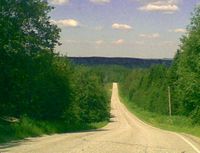JA:Key:easy_overtaking
 |
| 説明 |
|---|
| 追い越しがしやすい場所であることを示します。 |
| グループ: プロパティ |
| 適用できる要素 |
| 関連項目 |
| 状態:未定義 |
| ツール |
Specifying sections of roads where the road geometry and surrounding features make overtaking safer, i.e. places where your mother would consider overtaking if she knew them beforehand.
道路の線形や周囲の状況を踏まえた上で、「追い越しがしやすい場所」を示します。
Indications of safe overtaking sections
An easy/safe overtaking section is a place where the overtake can be completed without interruptions and with a several second safety margin, even if oncoming vehicles appear in sight during the overtake, given the conditions
- the "safe" road section was empty at the start of the overtake and
- the slower vehicle does not accelerate to prevent overtaking
For any highway with traffic in both directions
- The section may never have overtaking restrictions on that part of the road
- The driver must be able to see the road at least twice as far as they were to travel when driving at the maximum legal and possible speed and when overtaking a full length trailer (or other longest allowed vehicle) driving 10 km/h under the speed limit; remember that in addition to the length of the vehicle being overtaken there needs to be at least some 5 meters gap at both ends when changing the lane. Add to that time spent on the wrong lane, and a 2-5 seconds safety margin
- For a 100 km/h road, in countries where trailers may do only 80 but drive 88 most of the time, that means a visibility of at least 800 meters
- For a 80 km/h road that means at least 700 meters of free visibility
- For a 60 km/h curved mountain road, where the longest other vehicle could be a van with a trailer (10 meters), that means at least 250 meters visibility
- For a 40 km/h curved mountain road that means at least 170 meters of visibility
- If the road curves right (in countries driving on the right), the driver must see even further: the free section referred to above starts at the point which the driver can see when looking past the slower vehicle on the curbside and after he has had a chance to confirm that the road between the current location and that point is empty; no junctions (even minor tracks) may thus be on present the outside of the curve.
- The road may not have sudden small valleys that could "hide" an oncoming (low) passenger car.
- The road may not have intersections with other roads;
- Except where any vehicles approaching on the side road (at their speed limit speed) are also visible for the duration of the overtake
- The road may not have pedestrian crossings
- The road may not have central dividers
Many places where overtaking is allowed are not considered as "easy": overtaking on them often requires that the overtaking driver is prepared to abort the overtake (or prepared to exceed the speed limit considerably) if an oncoming vehicle appears during the overtake.
値
easy_overtaking=both: どちらの方向も比較的追い越しがしやすい。easy_overtaking=forward: 順方向には比較的追い越しがしやすい。easy_overtaking=backward: 逆方向には比較的追い越しがしやすい。easy_overtaking=no: (原則としてタグ付けしない。)
Default value on any road with only one lane in all directions should be assumed to be no. For oneway highways with more than one lane the value is equal to the direction of allowed traffic, although very short multilane sections can not be used for overtaking.
Other notes
You should split the way at the far ends of each easy overtaking section;
- At the start of the way tagged as easy_overtaking is the first point where one has the sufficient line of sight, even if not to the far end
- The length of the visible section must fulfill the conditions above for the whole length up to the point where the distance to the far end drops below the "safe" visibility distance
- Starting the overtake would not then be "safe" anymore when approaching the far end, but is left for interpreters to calculate from current speed vs. the speed limit